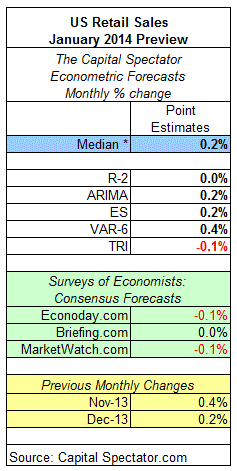US retail sales are expected to rise 0.2% in tomorrow’s January report vs. the previous month, according to The Capital Spectator’s median econometric forecast. The prediction matches the previously reported 0.2% increase for December. Meanwhile, the Capital Spectator’s median projection for January is above a trio of consensus estimates based on recent surveys of economists.
Here’s a closer look at the numbers, followed by brief definitions of the methodologies behind The Capital Spectator’s projections:

R-2: A linear regression model that analyzes two data series in context with retail sales: an index of weekly hours worked for production/nonsupervisory employees in private industries and the stock market (S&P 500). The historical relationship between the variables is applied to the more recently updated data to project retail sales. The computations are run in R.
ARIMA: An autoregressive integrated moving average model that analyzes the historical record of retail sales in R via the “forecast” package.
ES: An exponential smoothing model that analyzes the historical record of retail sales in R via the “forecast” package.
VAR-6: A vector autoregression model that analyzes six time series in context with retail sales. The six additional series: US private payrolls, industrial production, index of weekly hours worked for production/nonsupervisory employees in private industries, the stock market (S&P 500), disposable personal income, and personal consumption expenditures. The forecasts are calculated in R with the “vars” package.
TRI: A model that’s based on combining point forecasts, along with the upper and lower prediction intervals (at the 95% confidence level), via a technique known as triangular distributions. The combinations include the following projections: Econoday.com’s consensus forecast data and the four predictions generated by the models above (R-2, ARIMA, ES, and VAR-6). The forecasts are run in R with the “triangle” package.
